This was published 8 years ago
Nintendo Classic Mini NES review: more than just a nostalgic novelty
By Tim Biggs
While the most note-worthy thing about the Nintendo Classic Mini: Nintendo Entertainment System at the time of its launch was its incredible scarcity and overwhelming popular demand, little attention has initially been given to its quality as an actual device and how well it performs.
A miniature recreation of the Japanese gaming giant's 8-bit powerhouse from the 80s, the Mini has 30 classic games built in and promises to make them play nice with your modern AV equipment. It certainly makes good on that promise, and along the way provides one of the easiest ways to play some of the greatest games ever made.
Design
One of the core appeals of the Mini is its aesthetic — it just looks so adorable. Photos don't really do the thing much justice, but I was surprised by just how small it is. All the details, from the vents on the top to the red lettering on the (now non-functioning) cartridge slot have been perfectly shrunk down. It also weighs practically nothing, which can be problematic if you're playing with an enthusiastic cord-tugger.
The included controller is an exact to-scale replica of the NES controller. It still feels great with clicky buttons and a responsive d-pad, and it still digs into your hands with its pointy little edges. One baffling design choice is the woefully short cable that attaches the pad to the console. I can only assume Nintendo had a surplus of cords this length and needed to get rid of them, because there's no way it thought people would enjoy having to sit 75cm away from the box at all times.

The Mini is small enough to fit in the palm of your hand.Credit: Tim Biggs
The system uses the same controller connector found on the Wii remote, so if you want to add a second player but only have the one pad, you can use anything that works as a 'classic controller' attachment on Wii.
A big plus for the design is that it's powered by standard Micro-USB and outputs video via HDMI, meaning it should be painless to connect it to any screen at any time, without needing to find it its own permanent place in your entertainment unit. It looks better on a shelf anyway.
Booting up
Inside the Mini is a very simple Linux PC, and when you hit that power button it only takes around a second to start up and display a long line of games, which you can sort by year, publisher, title or whether they support two players.
This digital shelf of sorts uses all the games' original cover art, which look really cool in HD (the machine outputs in 720p, it must be noted, not the full 1080). Overall it's a pretty great way to frame the game selection, and it's all backed by a catchy original chiptune.
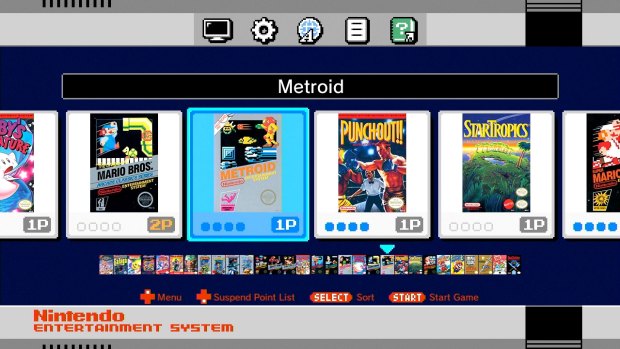
The Mini's home screen.
While Nintendo has made the much-appreciated gesture of scanning all the old manuals — with their weird phrasing and tiny black and white images — it has also constructed modern digital instruction guides for each game, so you can work out what to do if you've never played the game before. Unfortunately none of these live on the Mini, and instead must be read on your phone or a PC at a special website.
In terms of options, the Mini is fairly light, with a simple save state feature — which gives you four slots per game in which to record your progress — and a choice of three display modes to choose from.
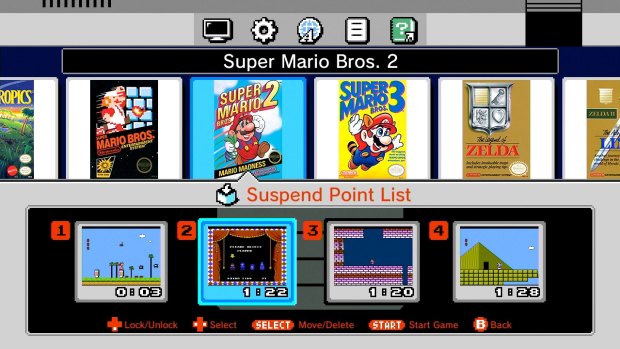
Be sure to save your games to one of the slots before moving on. You can even lock important ones to prevent accidental erasure.
'CRT' adds scanlines to the games in an attempt to make them look like they're being played on an old TV. It's a cute effect but doesn't add whole lot, and I haven't been inclined to switch it back on since first taking a look. '4:3' renders the game in the same wide-but-not-too-wide format used by the original NES, which is important if you want everything to be in the same scale you remember. My favourite mode, 'Pixel Perfect', renders every pixel as a square, making for a display that's narrower but heaps clearer on a HDTV.
The games
Since you have a finite selection of 30 games, and no option to add any more, it's a good thing Nintendo has put together a collection of 30 legitimately excellent games.
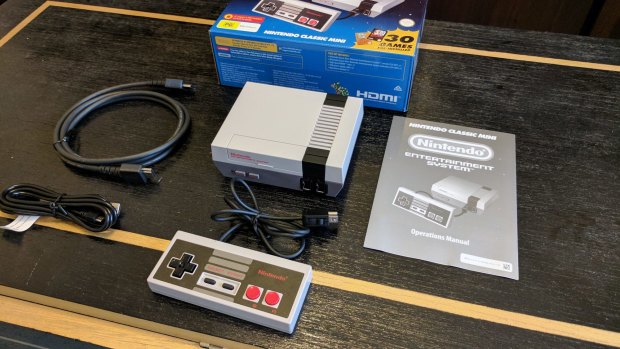
Everything you get in the box. You may need a longer HDMI and USB cable given the shortness of the controller cord.Credit: Tim Biggs
Spanning the 10 years from 1983's home version of Mario Bros to 1993's Kirby's Adventure, Nintendo has not only reached into its own back catalogue but has also reached out to other licence holders to lock down games originally published by Capcom, Konami, Square, Taito and Tecmo.
You will, of course, get more mileage out of some games then others.
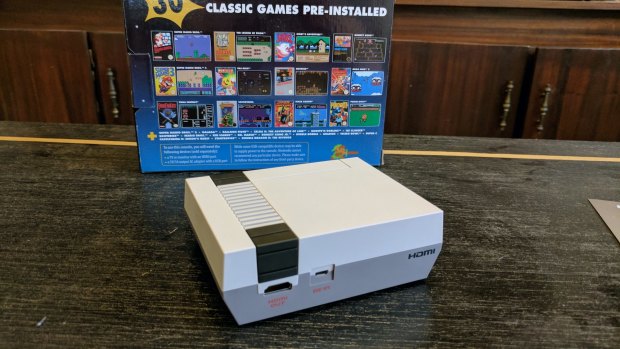
The rear of the console keeps it simple.
Lovers of arcade games will be happy to find several NES ports of classic coin-op machines, including Galaga, Gradius, Double Dragon II, Bubble Bobble and Ghosts 'n Goblins, but even though they're great it's hard to get excited about them when there are much better versions so easily available to us. Never have I specifically wanted to play the NES version of Pac-Man, for example, when the original has been perfectly replicated on every modern machine. The Nintendo-made coin-ops Donkey Kong and Mario Bros. are exceptions, since you don't see them every day.
Classic platformers built specifically for the NES make up the best the Mini has to offer, with Super Mario Bros. and its sequels, Castlevania, Mega Man 2, Kirby, Ninja Gaiden and Balloon Fight clearly standing the test of time.
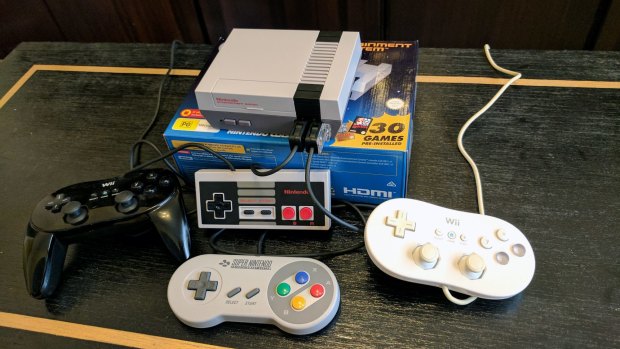
If you didn't manage to snag a second pad, you can use any Wii Classic Controller.
The machine also includes arguably the best adventure games and RPGs of the era too, with The Legend of Zelda, Zelda II, Final Fantasy, Metroid and StarTropics. The save state ability is a godsend for these games.
Regardless of your title of choice the emulation is top notch, with all the games bright, colourful and running without a hitch (as opposed to, say, the muddy and weird-looking versions of the games you get on Nintendo's own Wii U). Australian gamers who played a lot of NES in their childhood may be thrown off by the shift in speed — as these games all run at a smooth 60Hz while our old consoles were at 50Hz — but it's a learning curve that can be overcome.
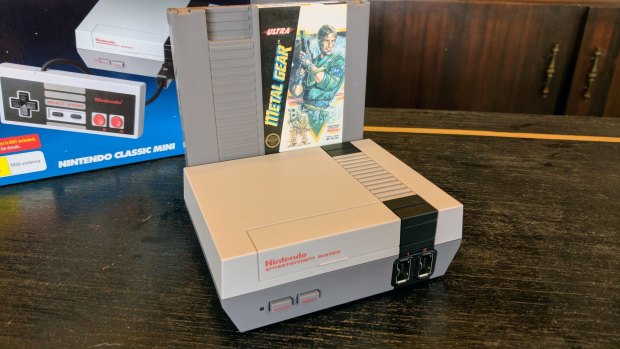
The Mini is around as wide as one original NES cartridge. Sadly, Metal Gear is not included.Credit: Tim Biggs
Should I get one (when I can)?
The Mini is a fantastic machine for $100. It looks great when you're not using it, it's quick and easy to set up and navigate, and most importantly it does a flawless job of presenting these old games in a modern format.
The risk for those only casually interested in video games is that you might play each game for 30 seconds and give up. Some of these games are quite hard, and — without the cinematics and flair of today's releases — they are generally much gamier than what you may be used to, with an emphasis on mastering mechanics and learning the game's rules. Even exceptions to this, like Legend of Zelda and Kirby's Adventure, are pretty obtuse by 2016 standards.
That said, I wholly believe that there is some of the best art, music, game worlds and mechanics of any game ever created in this collection, and this probably the most accessible way to experience them.
The easiest three groups to recommend this machine to are nostalgic gamers in their 30s and beyond, passionate gamers who missed these games the first time but are interested in discovering the classics, and Nintendo fans.
Others might understandably find it difficult to look past the aged presentation to appreciate the brutality of Dr Wily's robots, the wonder of Hyrule Field or the all-round perfection of Super Mario Bros. 3, but if any machine could make converts of those people, it's probably this one.
FULL GAMES LIST:
- Balloon Fight
- Bubble Bobble
- Castlevania
- Castlevania II: Simon's Quest
- Donkey Kong
- Donkey Kong Jr.
- Double Dragon II: The Revenge
- Dr. Mario
- Excitebike
- Final Fantasy
- Galaga
- Ghosts 'n Goblins
- Gradius
- Ice Climber
- Kid Icarus
- Kirby's Adventure
- Mario Bros.
- Mega Man 2
- Metroid
- Ninja Gaiden
- Pac-man
- Punch-Out!! Featuring Mr. Dream
- StarTropics
- Super C
- Super Mario Bros.
- Super Mario Bros. 2
- Super Mario Bros. 3
- Tecmo Bowl
- The Legend of Zelda
- Zelda II: The Adventure of Link
ALSO READ: